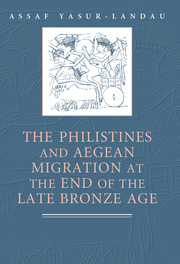Book contents
- Frontmatter
- Contents
- Acknowledgments
- INTRODUCTION
- 1 THE ARCHAEOLOGICAL IDENTIFICATION OF MIGRATION AND OTHER RANGES OF INTERREGIONAL INTERACTIONS
- 2 SETTING THE SCENE: THE MYCENAEAN PALATIAL CULTURE AND THE OUTSIDE WORLD
- 3 THE TWELFTH-CENTURY-BCE AEGEAN: POLITICAL AND SOCIAL BACKGROUND
- 4 PRECONDITIONS FOR MIGRATION
- 5 ALONG THE ROUTES
- 6 STRICTLY BUSINESS? THE SOUTHERN LEVANT AND THE AEGEAN IN THE THIRTEENTH TO THE EARLY TWELFTH CENTURY BCE
- 7 THE MATERIAL CULTURE CHANGE IN TWELFTH-CENTURY PHILISTIA
- 8 THE PHILISTINE SOCIETY AND THE SETTLEMENT PROCESS
- 9 A SHORT HISTORY OF THE AEGEAN IMMIGRATION TO THE LEVANT
- Bibliography
- Index
2 - SETTING THE SCENE: THE MYCENAEAN PALATIAL CULTURE AND THE OUTSIDE WORLD
Published online by Cambridge University Press: 04 August 2010
- Frontmatter
- Contents
- Acknowledgments
- INTRODUCTION
- 1 THE ARCHAEOLOGICAL IDENTIFICATION OF MIGRATION AND OTHER RANGES OF INTERREGIONAL INTERACTIONS
- 2 SETTING THE SCENE: THE MYCENAEAN PALATIAL CULTURE AND THE OUTSIDE WORLD
- 3 THE TWELFTH-CENTURY-BCE AEGEAN: POLITICAL AND SOCIAL BACKGROUND
- 4 PRECONDITIONS FOR MIGRATION
- 5 ALONG THE ROUTES
- 6 STRICTLY BUSINESS? THE SOUTHERN LEVANT AND THE AEGEAN IN THE THIRTEENTH TO THE EARLY TWELFTH CENTURY BCE
- 7 THE MATERIAL CULTURE CHANGE IN TWELFTH-CENTURY PHILISTIA
- 8 THE PHILISTINE SOCIETY AND THE SETTLEMENT PROCESS
- 9 A SHORT HISTORY OF THE AEGEAN IMMIGRATION TO THE LEVANT
- Bibliography
- Index
Summary
Tens of thousands of Mycenaean vessels found in excavations, from Sicily in the west to Jordan in the east, are powerful attestations to various forms of interregional interaction involving the palatial Mycenaean civilization, the dominant power in the Aegean between the late fifteenth century and the end of the thirteenth century bce (LHII–IIIB). It is likely that for Philistine migrants reaching the southern coast of Canaan in the early twelfth century bce, the Mycenaean palatial civilization – destroyed only one generation earlier – was fading rapidly from the realm of memory and entering the vast, vague, and perhaps mythical past. The Mycenaean palaces, each ruled by a powerful wanax that was supported by a literate administration and a circle of cultured elite, were a far cry from the postliterate, rough reality of the twelfth century, with its crude art and scarcity of raw material and resources.
Still, the LHIIIB Mycenaean interaction could have left a legacy of knowledge that would be highly advantageous to the Aegeans taking part in twelfth-century interactions. Thus, for example, information about foreign lands and sea and land routes used for trading in the LHIIIB period could have been used for decision making about migration destinations during the LHIIIC period. Knowledge about the organization of maritime expeditions for war and trade in the final palatial era could have been used to organize pirate raids and colonization parties during the postpalatial era.
- Type
- Chapter
- Information
- Publisher: Cambridge University PressPrint publication year: 2010



